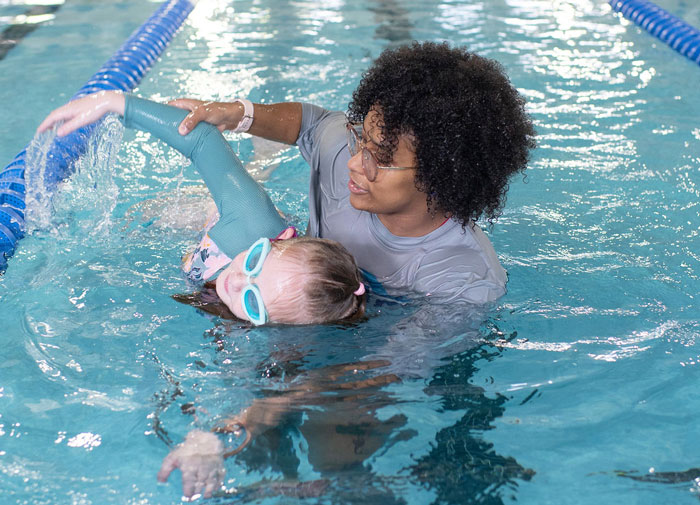There are many organizations and businesses dedicated to aquatic safety, which is good news as drowning is still the single leading cause of death for children ages 1 to 4, according to the National Drowning Prevention Alliance (NDPA), a nonprofit organization “dedicated to reducing the incidence of drowning and preventing tragedy around water.”
Adam Katchmarchi, chief executive officer at NDPA, pointed out that there’s no single solution to prevent all drownings. Their approach centers on using multiple intervention strategies to reduce the risk of drowning: “the five layers of protection.” These layers include barriers and alarms; supervision; water competency; life jackets; and emergency preparation. “Each prevention strategy/layer isn’t designed to work independently,” he said. “For example, supervision can fail, a pool fence’s gate might be propped open, an alarm’s batteries expire, etc.”
Katchmarchi said it’s important to remember that drowning doesn’t discriminate—everyone is at risk. And while drowning data in the U.S. does identify populations that are at increased risk of drowning, examining factors like socioeconomic status, race, gender and culture, among other categories, he said not all solutions can be approached with a one-size-fits-all mindset, as the U.S. is culturally and geographically diverse. “That means we need to approach each culture in a unique way that allows us to understand their relationship with water and identify interventions that will work for each community.”

Additionally, there are a multitude of climates and weather patterns playing a role, adding to each community’s unique challenges. That’s why “…we need solutions and resources that are informed nationally, yet implemented locally,” Katchmarchi said.
NDPA works with all industries and sectors that touch water safety and drowning prevention, according to Katchmarchi, providing education and resources “for aquatic facilities to both make their facilities and practices safer, but also to help them educate their patrons about water safety.” Recently, they launched their first Aquatic and Pool Professional Toolkit, designed to make resources more accessible, which is available at their website.
Tom Griffiths is founder of Aquatic Safety Research Group (ASRG), which provides water safety and risk management programs and services, and he discussed some safety considerations for the facility design phase. “Not only should they include video cameras and drowning detection systems during planning, but they should place a safety office with an unobstructed view of the water. We like lots of shallow water and the use of additional lifelines.”
Warning signage is important, which Griffiths said should be “stand-alone signs not camouflaged with a dozen other rules. Use warning shapes, warning colors, warning symbols.” Important warnings include No Diving and No Extreme Breath Holding, as well as signs encouraging life jacket use and parental supervision.
And Griffiths said they strongly encourage all pools to create “rescue stations” that are conspicuous and well-marked with “everything that is needed for an emergency: phone, AED, O2, shepherd’s crook, ring buoy, etc.” These should be strategically placed. “In our experience during facility audits, vitally important emergency and rescue equipment is spread out throughout the facility, causing delays for lifeguards and the public.”
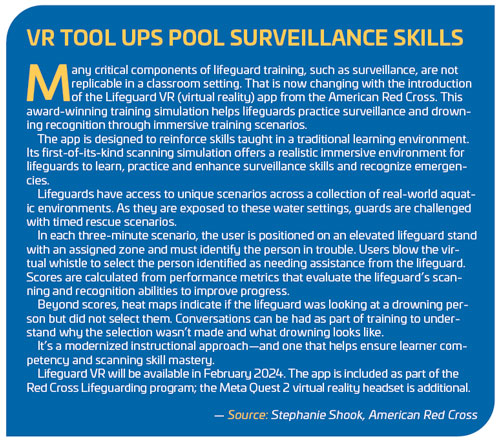
What are some other issues that Griffiths’ group might find during facility safety evaluations? “Unfortunately, we see too many pump and pool chemical storage rooms that are unclean and unsafe,” he said. “We recommend super spring cleaning and the removal of liquids and other substances that are incompatible with pool chemicals. We encourage the removal of trip and slip hazards. In the facility itself, we often see slippery decks and floors, inadequate warning signage and a lack of emergency and rescue equipment.”
Shawn DeRosa, founder of DeRosa Aquatic Consulting, said that “attentiveness of parents over their children” remains a top concern at aquatic venues. “In nearly all drowning cases I’ve been involved in, a lapse in supervision of the child contributed to the drowning.”
DeRosa believes the public’s understanding of swimming has shifted over the years, and that in the past swimming inferred having completed swimming lessons to a certain level such as intermediate or advanced, whereas now parents often think of their kids as swimmers if they can jump in the water and doggie-paddle back to the edge. “This is a much different assessment of what swimming is. As…we find fewer facilities doing deep water swim tests, there is less impetus for children to learn to swim.”
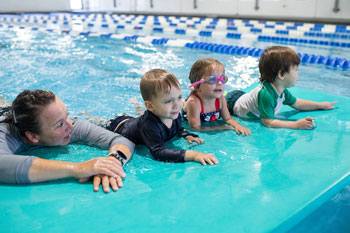
DeRosa also discussed some safety considerations in the design phase, including “the glare effect of light and windows.” He agreed that from an aesthetic standpoint, large glass windows are very appealing and can “activate the space.” However, from an operational standpoint, they can be challenging, and even with glazing and thoughtful positioning, glare can still occur. He said the use of a shade during the day can help, but these need to be maintained properly, “including an annual preventive maintenance of the gears, and used during daylight hours, otherwise glare may be an issue,” requiring “more lifeguards to be positioned such that the glare doesn’t create an obstruction to their view of their zone.”
The number of lifeguards present at a pool and whether they’re stationary or roving also affects safety, according to DeRosa. “We know that one lifeguard cannot adequately see the entire bottom of a traditional 25-yard, six-lane pool from a stationary position.”
He explained that this concept was brought to light by Griffiths, whose video “Disappearing Dummies” demonstrated that ripples or glare on the water’s surface and racing lines on the bottom each served to disguise manikins on the pool’s bottom. “This research led to a paradigm shift in the industry where lifeguard training agencies began to emphasize scanning from the bottom up and where visual alertness training and audits became necessary to determine if lifeguards were properly positioned and able to see all sections of their zone.”
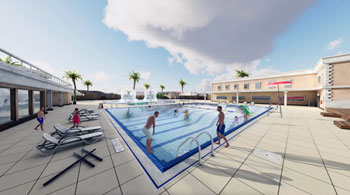
Griffiths also developed a systematic approach to lifeguard surveillance based on scientific research and studies with thousands of lifeguards called the “Five Minute Scanning Strategy.” He said, “Our sit, stand and stroll strategy increases attention and concentration while reducing boredom through increased respiration and circulation.” Based on this strategy, Griffiths also developed a lifeguard station, which he said “promotes movement while offering additional viewing angles. We also encourage a variety of guard station heights in addition to foot patrols on the deck or beach.”
With regard to design, DeRosa also mentioned wing walls—structural projections into the pool intended to provide separation within the pool. “While the design may require a peninsula to address changing water depths, they do alter sightlines for lifeguards, and children often try to stand or walk on them—this should be discouraged.”
He also explained that lifelines are often found at the five-foot depth mark, as many codes require for separating shallow from deep water. But that depth may be well above young children’s mouths, and many drownings occur in about four feet of water. “If we really wanted to make venues safer for young children, we’d install rope anchors for a lifeline at the three to three-and-a-half-foot depth and provide operators the option of helping create a shallower space in which to attempt to contain young children,” though this doesn’t mean the five-foot lifeline should go away.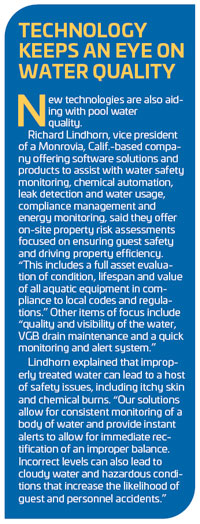
More aquatic facilities are offering life jackets as part of their safety arsenals, and ASRG oversees a nonprofit Note & Float Life Jacket Fund, which donates life jackets to pools, identifying non-swimmers and floating them in properly fitting U.S. Coast Guard-approved life jackets. “We’ve collected data on our Note & Float program and for the most part, we see a water safety trifecta: reduced water rescues, increased attendance and swim lessons, and increased patron satisfaction,” said Griffiths.
The nonprofit Association of Aquatic Professionals (AOAP) provides drowning prevention education and promotional materials as well as swim lesson grants. They also maintain a life jacket grant program, available to any nonprofit member agency under certain requirements, according to AOAP Executive Director and CEO Juliene Hefter. “We require that if they’re chosen, they use the Coast Guard-approved life jackets that we provide during learn-to-swim programs to teach the importance of and the proper way to use and wear life jackets. These must also be made available, free of charge, to anyone during open swim, especially those who are weak or non-swimmers.” She emphasized that “These life jackets do not take away from the requirement of a parent to be in the water within an arm’s reach of those children at all times.”
Katchmarchi explained that it’s a great risk reduction practice for facilities to utilize swim tests to identify weak or non-swimmers before they enter deep water, and he agreed that life jackets can reduce the risk of drowning at facilities when used appropriately. However, he cautioned that there are concerns that the overuse of life jackets may create a false sense of security and said there’s a risk of other layers of protection not being practiced while they’re being utilized. “These devices are not babysitters, they’re not a replacement for touch supervision and they don’t teach a child to swim. Parents and caregivers should always practice touch supervision with weak and non-swimmers when in water.”
The recent pandemic knocked many things backward, and the aquatics industry was not spared. Some facilities were shuttered, and learn-to-swim programs were forced to take an extended pause. And existing lifeguard shortages were exacerbated. “Anecdotally, we know this is still a problem, both with lifeguards and programming staff such as swim lesson instructors,” said Katchmarchi. “We need community pools that are accessible to the public for both safer swimming environments and professional supervision, but we also need these facilities—and instructors—to be able to train children and adults in learn-to-swim.” He added that some communities are thriving as far as recreational aquatics and programming while others are still recovering from the pandemic’s effects.
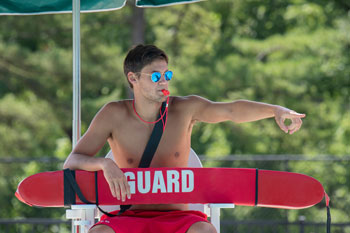
Since 2012, the nonprofit Pool and Hot Tub Alliance (PHTA) has funded swimming lessons for more than 300,000 children across the country through their Step into Swim campaign, according to PHTA President and CEO Sabeena Hickman, “extending a safe and healthy pool experience to underserved communities through free or reduced-cost access to swim lessons. Learn-to-swim providers are encouraged to submit an online grant application, including detailed information on how they’ll support families in need of financial assistance. Once approved, grant recipients continue building their relationship with Step into Swim and share impact updates on how their grant-funded programs support their local communities.” The campaign also raises awareness of water safety, sharing press releases, blog posts, media articles and educational materials on its website and across social media for parents, caregivers, swim lesson providers and aquatic facilities, she added.
New products and technology present one of the largest areas of innovation in water safety, according to Katchmarchi, particularly with drowning prevention and detection. “We’re thrilled to see new technologies come to market that are utilizing the latest advancements in artificial intelligence and other areas. However, we do want to ensure that these systems are tested and are meeting established standards.”
Software integrates with installed pool cameras to continuously scan the pool, and systems can track movements of all swimmers. Built-in notification systems produce alarms on smartwatches, phones, flashing lights and other devices when danger is perceived. Lightweight wearables enable guards to know immediately if anyone is submerged longer than is deemed safe. Location indicators guide guards toward swimmers in question. Systems can enable facility-wide alerts the moment a guard enters the water.
“With staffing challenges, or difficulties in seeing all areas of a zone, these systems help provide an extra layer of protection against drowning,” said DeRosa. “Moreover, use of a drowning detection system may allow a facility to reduce the number of lifeguards needed to adequately cover the venue perhaps by one or more lifeguards.”
He said oftentimes these systems aren’t considered in part because of the added operational cost and perhaps because they’re not mandated by regulation. But he computed the staff savings cost for one year based on lifeguard wages for each hour of operation, helping to provide a cost-benefit analysis. “The service agreement for the drowning detection program is likely going to cost less than the amount saved by reducing staff size by one lifeguard, and the entire facility is then covered by an additional layer of drowning prevention technology to assist lifeguards.”
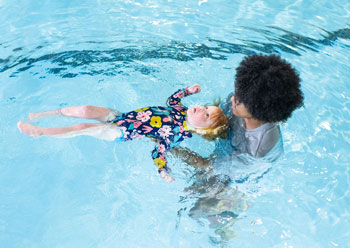
“We encourage all facilities to research the latest drowning prevention products,” said Griffiths. “Additional technologies are being developed and the prices should be going down. Humans are not vigilant, but the drowning detection technologies are.”
Added Hickman, “Safety should always be a priority. Covers, fencing, sensors and alarms—on top of adult supervision—are all layers of protection to help prevent drowning and keep families safe around water.”
Many of the organizations involved with drowning prevention and water safety team up to help one another further their missions. May is National Water Safety Month (NWSM), and Hickman explained that it’s led by a coalition including PHTA, the American Red Cross, NDPA, the National Recreation and Park Association (NRPA) and the World Waterpark Association (WWA). “Each organization has their own events during the month, but we cross-promote and share them all through NWSM for a concerted effort to reach as wide an audience as possible in the name of water safety.”
Since May is the kickoff to summer, Hickman said it’s “a timely opportunity for aquatic facilities to lean into programming and education around water safety.” The NWSM website has resources for aquatics professionals on how to host water safety fairs and other events, and the coalition runs a series of programs within their individual organizations. PHTA promotes the Step into Swim campaign. WWA launched the World’s Largest Swimming Lesson, which takes place every June, and the global event has seen participation from 380,000-plus children.
The American Red Cross teaches swim lessons and lifeguard training, and also offers free water safety courses for parents and caregivers. NRPA collaborates with the Pool Safely campaign from the U.S. Consumer Product Safety Commission, to promote the importance of water safety at park and rec facilities. And NDPA leads the Water Safety Champion program, which gives aquatics professionals access to resources to raise awareness of drowning prevention.
The annual AOAP Conference & Expo takes place in February, and Hefter said that “all of our sessions have something to do with safety in some way, shape or form.” She shared that this year they’ve partnered with NDPA, and “when someone registers for the AOAP Conference they’re also automatically registered to attend any NDPA sessions as well.”
Added Katchmarchi, “Attendees will have the opportunity to attend over 100 sessions and educational events, meet with over 100 vendors in our expo hall and network with over 1,000 attendees who all work in aquatics, water safety and facility management. We’re excited to be hosting our conference alongside AOAP!” RM



